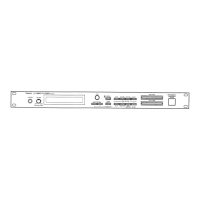*
The size of the requested dau does not indicate the number of bytes that will
malce up
a
DTI
message,
but represents
the address
fields where the requested data resides.
*
Some models are
subject to
limitations
in data format
used
for a single transaction.
Requested data, for
example,
may have
a limit
in length or must
be divided Into
predetermined
address fields before it is exchanged across the interface.
*
The
same number
of bytes
comprises
address and size data,
which, however,
vary with
the Model-ID.
*
The error
checking
process uses a checksum that provides a bit pattern where
the least
significant 7 bits are zero when values
for an
address, size, and that checksum
are
summed.
#Dataset1:
DTI
(12H)
This
message corresponds to
the
actual data transfer process.
Because
every
byte
in
the data is assigned a unique address, a DTI message can convey
the
starting address
of
one or more
data as
well
as a series of data formatted in an
address- dependent order.
41
Device
B
requesting
data from Device A
Device
B sends an RQl message to Device A.
Checking
the
message. Device
A
sends
a
DTI
message back to
Device
B.
Device
(A) Device
(B)
[Data
set 1]
-^
[Data set 1]
^-
*
More
than 20m sec
time internal.
[Data set
1]
;
^-
[Data set 1]
'
^-
-CRequest
data]
The
MIDI standards inhibit non-real time messages from interrupting
an
exclusive
one.
This fact
is inconvenient for the devices that support
a
"soft-through"
mechanism. To
maintain
compatibility with such
devices,
Roland has limited the DTI to 256 bytes
so
that an
excessively
long
message is sent out
in
separate
segments.
Byte
Description
FOH Exclusive
41H
Manufacturer ID (Roland)
DEV Device
ID
MDL
Model ID
12H Command ID
aa
H Address
MSB
LSB
SL
H
m
Da
Ch
ta
ack
sum
F7H End of
exclusive
*
A DTI message is capable of
providing
only the
valid
data among those specified by
an
RQl
message.
*
Some models are subject to limitations in data
format
used for a single
u^nsaction.
Requested
data, for example, may
have
a limit
in length
or
must
be
divided
into
predetermined address fields before it is exchanged across the interface.
*
The number
of bytes comprising address data varies from one Model-ID to another.
*
The error checking process uses a
checksum that provides
a
bit pattern where the
least
significant 7 bits are zero
when values for an address, size, and that checksum
are
summed.
#Example of
Message Transactions
9
Device
A
sending data to
Device
B
Transfer
of
a DTI
message is ail that
takes
place.
Device
(A)
Device
(B)
[Data set
1]
^-
*
More
than 20m sec time internal.
[Data set 1]
[Data set 1]

